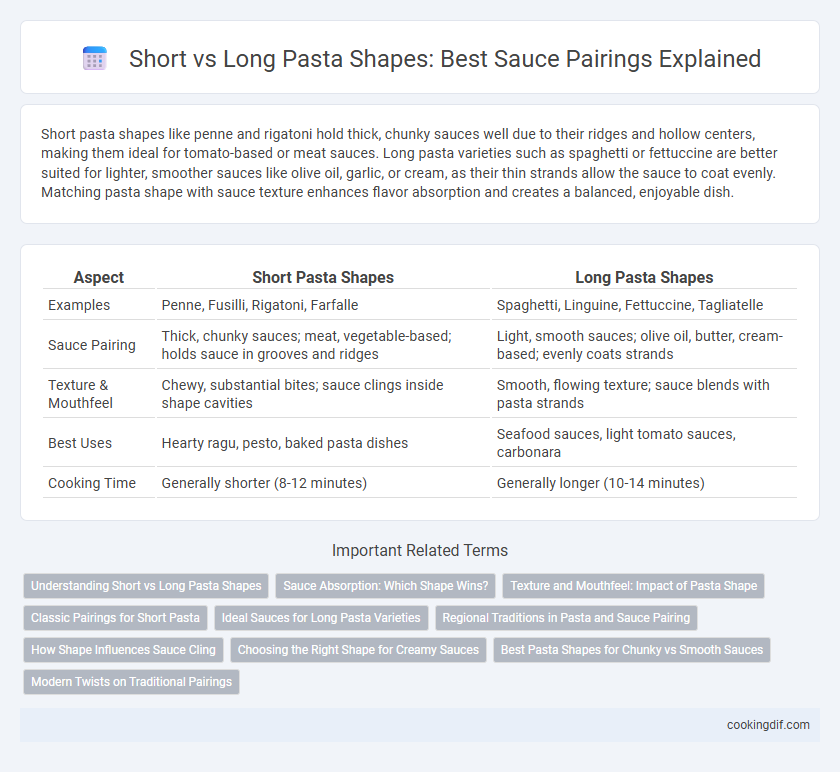Short pasta shapes like penne and rigatoni hold thick, chunky sauces well due to their ridges and hollow centers, making them ideal for tomato-based or meat sauces. Long pasta varieties such as spaghetti or fettuccine are better suited for lighter, smoother sauces like olive oil, garlic, or cream, as their thin strands allow the sauce to coat evenly. Matching pasta shape with sauce texture enhances flavor absorption and creates a balanced, enjoyable dish.
Table of Comparison
| Aspect | Short Pasta Shapes | Long Pasta Shapes |
|---|---|---|
| Examples | Penne, Fusilli, Rigatoni, Farfalle | Spaghetti, Linguine, Fettuccine, Tagliatelle |
| Sauce Pairing | Thick, chunky sauces; meat, vegetable-based; holds sauce in grooves and ridges | Light, smooth sauces; olive oil, butter, cream-based; evenly coats strands |
| Texture & Mouthfeel | Chewy, substantial bites; sauce clings inside shape cavities | Smooth, flowing texture; sauce blends with pasta strands |
| Best Uses | Hearty ragu, pesto, baked pasta dishes | Seafood sauces, light tomato sauces, carbonara |
| Cooking Time | Generally shorter (8-12 minutes) | Generally longer (10-14 minutes) |
Understanding Short vs Long Pasta Shapes
Short pasta shapes like penne, rigatoni, and fusilli are ideal for thick, chunky sauces because their grooves and ridges trap bits of meat and vegetables effectively. Long pasta shapes such as spaghetti, fettuccine, and linguine work best with smooth, lighter sauces like olive oil-based or simple tomato sauces, allowing even coating along the strands. Matching pasta shape to sauce enhances texture and flavor integration, providing a balanced culinary experience.
Sauce Absorption: Which Shape Wins?
Short pasta shapes like penne and rigatoni excel in sauce absorption due to their ridges and hollow centers, trapping thicker sauces such as chunky tomato or meat-based ragu effectively. Long pasta varieties like spaghetti or fettuccine allow thinner sauces like olive oil, garlic, or light cream to coat strands evenly but absorb less sauce overall. For maximum sauce retention, short pasta shapes dominate by naturally holding more sauce within their crevices and surfaces.
Texture and Mouthfeel: Impact of Pasta Shape
Short pasta shapes like penne and rigatoni have ridges and hollow centers that trap chunky or thick sauces, enhancing texture by creating bursts of flavor in every bite. Long pasta shapes such as spaghetti or fettuccine provide a smooth, continuous mouthfeel ideal for lighter, oil-based or creamy sauces that cling evenly along their strands. The choice between short and long pasta directly influences the sauce's distribution and texture, affecting overall sensory experience.
Classic Pairings for Short Pasta
Short pasta shapes like penne, rigatoni, and farfalle are ideal for thick, chunky sauces such as ragu, pesto, and vegetable medleys because their ridges and hollow centers hold sauce effectively. Classic pairings include penne with arrabbiata or vodka sauce, rigatoni with meat ragu, and farfalle with creamy mushroom or tomato-based sauces. These shapes enhance flavor absorption and texture contrast, making each bite rich and satisfying.
Ideal Sauces for Long Pasta Varieties
Long pasta varieties such as spaghetti, linguine, and fettuccine are best paired with light to medium-bodied sauces like tomato-based marinara, creamy Alfredo, and garlic olive oil blends that cling smoothly to their slender strands. These sauces enhance the texture and allow each bite to evenly distribute flavors without overpowering the pasta's delicate consistency. Ideal choices emphasize balance and coating ability, optimizing flavor absorption and delivering a satisfying mouthfeel.
Regional Traditions in Pasta and Sauce Pairing
In Italian regional traditions, short pasta shapes like rigatoni and penne are favored for thick, chunky sauces typical of Southern Italy, such as rich tomato-based ragu or arrabbiata, because their grooves and hollow centers trap the sauce effectively. Northern Italy prefers long pasta shapes like spaghetti or tagliatelle paired with lighter, smoother sauces such as butter-based or cream sauces, reflecting the region's emphasis on delicate flavors. This regional approach to pasta and sauce pairing enhances the harmony between texture and taste, preserving authentic Italian culinary identities.
How Shape Influences Sauce Cling
Short pasta shapes like penne and rigatoni have ridges and tubes that trap chunky and thick sauces, enhancing sauce cling. Long pasta shapes such as spaghetti and fettuccine allow smooth, thin sauces to coat evenly along their strands. The texture and surface area of each pasta shape directly influence how well the sauce adheres and delivers flavor in every bite.
Choosing the Right Shape for Creamy Sauces
Short pasta shapes like penne, rigatoni, and fusilli are ideal for creamy sauces because their ridges and hollow centers trap and hold thick sauces effectively, enhancing each bite with rich flavor. Long pasta varieties such as fettuccine and linguine provide a smooth surface that complements creamy sauces, allowing the sauce to coat evenly without clumping. Selecting pasta shapes with textures that can capture and cling to creamy sauces maximizes taste and texture in every serving.
Best Pasta Shapes for Chunky vs Smooth Sauces
Short pasta shapes like penne, rigatoni, and farfalle have ridges and tubes that cling well to chunky sauces with vegetables or meat pieces. Long pasta shapes such as spaghetti, linguine, and fettuccine provide a smooth surface ideal for thinner, creamy, or oil-based sauces that coat without overwhelming. Choosing the best pasta shape based on sauce texture enhances flavor absorption and overall dish harmony.
Modern Twists on Traditional Pairings
Short pasta shapes like penne or rigatoni effectively hold chunky sauces and roasted vegetable medleys, enhancing texture contrast in modern Italian dishes. Long pasta varieties such as linguine or bucatini complement smooth, oil-based sauces infused with citrus or herb essences, adding a fresh twist to classic recipes. Chefs now experiment by pairing traditional shapes with unconventional sauces, like spicy romesco with conchiglie or creamy avocado blends with fettuccine, driving innovation in pasta pairings.
Short shapes vs long shapes for sauce pairing Infographic

 cookingdif.com
cookingdif.com